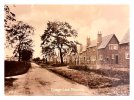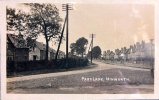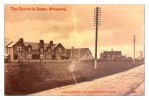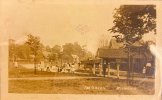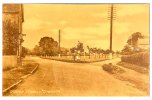There has been a thread on the canal page regarding transport of night soil by boat to various canal wharves for distribution by the farmers.
Birmingham, it seems, adopted a progressive approach from the early 1850's towards the transport of sewage. That began with the making of interception sewers that transported sewage to the Tame and certain farmers began to irrigate their fields with river water. Sewage in the Tame came from a variety of sources along the north and south branches of the Tame and did little for the fish etc that were there.
The 1862 report to Parliament has the following extract explaining its inception
1305. Mr. Adderley. ] You are the Borough Surveyor of Birmingham ?—I am.
1306. Will you describe the system of sewage in operation at Birmingham?-The system of sewerage for the town is a combined one, of brick and pipes.
1307. When was it made ?—I think that, perhaps, I had better first state that, prior to 1851 , Birmingham was divided into five districts, each having different Boards of Commissioners.
1308. Was it in the year 1851 that the new system of sewerage, with brick and pipes, was commenced ?-The system was partially commenced by one of the five bodies which I have mentioned, namely, by the Commissioners of the Street Acts before 1851 , and the Council in 1851 obtained the control of the whole, and commenced to carry out a general system.
1309. In what year did the new system of sewerage come into operation ?-It was commenced about 1852 ; it is not completed at the present time.
1310. Did Birmingham, for the first time, discharge all its sewers into the adjoining river in the year 1852 ?—About 1853.
1311. Chairman. ] That is to say, all the houses which were drained ?-All the houses which were drained ; they were main sewers which were constructed, what we call intercepting sewers ; they picked up the whole of the smaller sewers which then discharged into the rivers and brooks, so that in point of fact the bulk of the sewage of the town was delivered into the Tame at that time.
1312. Mr. Adderley. ] In 1853 ?—Yes.
1313. That was the end of the cesspool system in Birmingham?-It was the beginning of the end, we have not come to the end of it yet.
1314. There are still cesspools in Birmingham which do not discharge into the Tame ?—Yes, very many.
The use of the water closet seems to have been for those that could afford it and thus that form of sewage only formed a part of the disposal of sewage and was an improvement on the cesspool system
Night soil was once a common form that was collected from the outside toilet areas by cart for distribution to farmers, but also came the canal side depots that dealt with all forms of rubbish and night soil.
The gradual investment in ways to improve the disposal of sewage led to the creation of the sewage farm, such as existed at Saltley.

